Secret cameras,drones and covert surveillance by EPA officers had discovered what appeared to be a massive,illegal contaminated waste dump containing asbestos in northern Sydney on land part-owned by an alleged associate of the Rebels motorcycle gang.
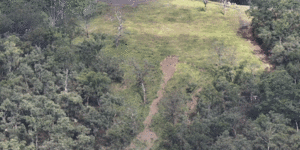
An aerial view of the Wheeny Creek site in northern Sydney,now partially grassed over.
But nearly four years after it was discovered by authorities,the Wheeny Creek site in the Hawkesbury region still is not cleaned up,and now appears to be leaking contaminated waste into a protected wetland that borders the Blue Mountains World Heritage area.
AHeraldinvestigation has uncovered internal documents that shed light on the environmental regulator’s battles with alleged organised crime networks involved in systematic illegal asbestos dumping for many years before the asbestos-in-mulch crisis made headlines in February.
When investigators found the northern Sydney dump in 2020 at Wheeny Creek,the agency saw it as an opportunity to press for tough action that would send a message that the EPA meant business,documents show.
“The sheer amount of dirty stuff at this particular site potentially puts it in the category of an environmental tragedy,” said one senior EPA staff member with knowledge of the case,speaking anonymously because staff have been warned not to talk to the media.
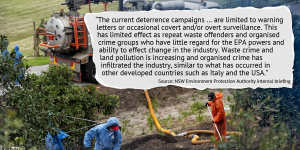
Workers testing for asbestos in Rozelle.Graphic:Kirsten Burghard
“You’re talking about a natural wetland with all sorts of rare frogs,bats,skinks under threat.”
But serious allegations of mismanagement in the Wheeny Creek investigation were raised with the environmental regulator’s leaders,according to internal emails seen by theHerald.
Another senior investigator,who declined to be identified as he is not authorised to speak publicly,emailed the environmental watchdog’s leadership in April last year,outlining problems with the agency’s investigation.
It was “apparent that these investigations[have] not been managed properly”,the investigator wrote,and the Wheeny Creek operation had “lost its way”.

Andrew Hughes owns waste transport and construction company Ant Civil Pty Ltd.Supplied
Covert surveillance cameras were removed while they were still gathering evidence,the investigator told management. Concerns were also raised about cost-cutting causing problems for pollution tests and EPA lawyers allegedly failing to communicate with police lawyers who were also involved in the case.
The site is part-owned by Andrew Hughes,an alleged associate of the Rebels outlaw motorcycle gang who owns a waste transport and construction company,Ant Civil Pty Ltd. Hughes declined to respond to questions about the site. He is contesting a case against him brought by the EPA in the Land and Environment Court.
There is no suggestion material from the Wheeny Creek site is linked to the current asbestos crisis,in which asbestos was found in mulch at more than 75 sites around the state including schools,parks,a supermarket and a hospital.
About 100,000 tonnes of material was allegedly dumped at Wheeny Creek,including earth and construction rubble from Sydney’s booming building sector and asbestos – the fibrous mineral that can cause cancer if inhaled.
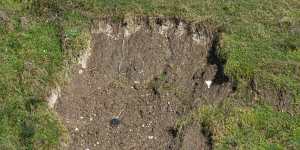
A close-up of the Wheeny Creek property that appears to show buried construction rubble crumbling downhill.
Drone footage of the site taken this month shows what appears to be contaminated soil crumbling down a steep hillside into a valley lined with wetlands,waterfalls and pockets of subtropical rainforest.
The senior investigator who raised concerns about the site’s investigation last year warned the EPA’s leadership that the case was stagnating.
“This site is the largest by volume land pollution investigation that the NSW EPA has investigated,” the investigator wrote. “We need to divert all resources to have this investigation progressed or we risk the reality that we will not proceed with a tier 1 land pollution charge.”
The warning was prescient. Rather than tier 1 charges – the strongest sanctions the agency can apply,relating to large-scale deliberate pollution – the agency is largely proceeding with lesser tier 2 charges in the case that is now before the NSW Land and Environment Court.
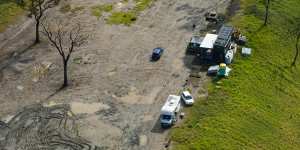
Vehicles at the alleged dump site.
The site was raided by EPA officers in 2020 and samples taken that confirmed the presence of asbestos,but the investigation stalled,insiders said. Trucks were allegedly still dumping loads of unknown material at the site last year,an investigator told the organisation’s management.
In response to detailed questions,the EPA said it stood by its track record of more than 800 pollution prosecutions since 2012,winning over 90 per cent of them,but would not discuss the details of the Wheeny Creek case.
“The EPA has commenced prosecutions in the Land and Environment Court against the owner and his company for a total of six offences,with maximum penalties for the offences charged ranging from $250,000 to $2 million,” a spokesperson said.
Asked why stronger prosecutions were not pursued,the agency said in a statement:“All investigations by the NSW EPA are thorough and comprehensive and we take the strongest regulatory action and prosecutions based on available evidence and in accordance with our policies and guidelines.”
The EPA did not directly respond when asked why the site had not been cleaned up.
Internal EPA documents show that in 2020 the regulator’s Waste Crime Task Force was tracking at least seven Sydney waste and construction operators who it believed were involved in large-scale illegal dumping,including the mixing of asbestos-tainted waste in with soil to disguise it as “clean fill”.
With Sydney undergoing a construction boom,thousands of buildings were being demolished or altered each month,many containing asbestos.
Some waste operators were charging fees for removing contaminated waste,then avoiding paying charges at a landfill site by dumping the waste or illegally mixing it with other products,the agency said in a briefing note on the illegal industry.
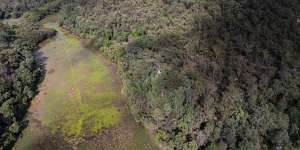
The wetland in a valley below the Wheeny Creek site.
It can cost over $700 per tonne to safely remove asbestos and place it in a licensed landfill,but unscrupulous operators were pocketing the cash and dumping thousands of tonnes of asbestos-laced waste illegally.
Methods used to hide illegal asbestos dumping included faking paperwork to support claims that contaminated material has been legally disposed of in landfill sites,and falsifying weighbridge data to disguise truck movements,EPA staff told theHerald.
They also expressed the view that charging fees for asbestos disposal under the state’s so-called “waste levy” had inadvertently helped to support the business model of large-scale illegal dumpers.
The levy is designed to encourage recycling by making dumping material in landfill more expensive than recycling. But asbestos often cannot be recycled.
“The paradox is that the cost of proper ACM[asbestos contaminated material] disposal may be a perverse incentive to illegal dumping,” the NSW Ombudsman found in a report to parliament in 2017.
The waste levy,and the inclusion of asbestos in it,is under review by the state government.
One briefing note on the illegal industry said a common method for illegal dumpers was to advertise “free fill” for people who wanted bulk soil to level a property or fill a dam. A few loads of clean soil would be provided,then contaminated construction waste would be used for the majority of the work before a clean layer was added on top.
A briefing prepared ahead of the Wheeny Creek investigation said the state’s illegal dumping deterrence campaign,which involved sending warning letters and occasional surveillance of suspected dumps,was ineffective against large illegal waste operators.
“This has limited effect as repeat waste offenders and organised crime groups who have little regard for the EPA powers and ability to effect change in the industry,” the briefing says.
“Waste crime and land pollution is increasing and organised crime has infiltrated the industry,similar to what has occurred in other developed countries such as Italy and the USA.
“Public interest and confidence in the ability of the EPA to pursue these waste offenders and provide effective strategies to deter same must be seen to be done and viewed as cutting edge and proactive,making the EPA a ‘first class’ regulator and investigative body.”
Start the day with a summary of the day’s most important and interesting stories,analysis and insights..